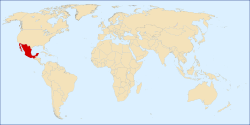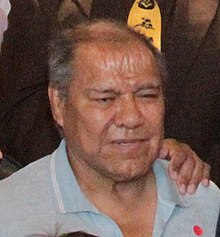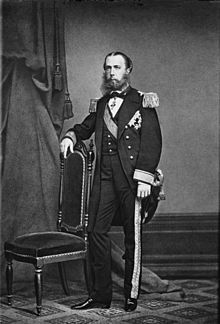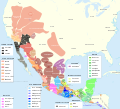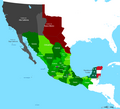Portal:Mexico
|
The Temple of Warriors at Chichen Itza, Mexico
¡Bienvenido! Welcome to the Mexico portal
Mexico, officially the United Mexican States, is a country in the southern portion of North America. It covers 1,972,550 km2 (761,610 sq mi), making it the world's 13th-largest country by area; with a population of almost 130 million, it is the 10th-most-populous country and the most populous Spanish-speaking country. Mexico is organized as a federal constitutional republic comprising 31 states and Mexico City, its capital. It shares land borders with the United States to the north, with Guatemala and Belize to the southeast; as well as maritime borders with the Pacific Ocean to the west, the Caribbean Sea to the southeast, and the Gulf of Mexico to the east.
This is a Featured article, which represents some of the best content on English Wikipedia.
Aries is the ninth studio album by Mexican recording artist Luis Miguel. It was released by WEA Latina on 22 June 1993. After attaining commercial success in 1991 with his previous album, Romance, Luis Miguel decided to return to a style similar to his earlier work, featuring pop ballads and dance numbers with R&B influences. The record was produced by Miguel, who was assisted by Kiko Cibrian, Rudy Pérez, David Foster, and Juan Luis Guerra. Three singles were released to promote the album. The first two singles, "Ayer" and "Hasta Que Me Olvides," topped the US Billboard Hot Latin Songs chart and the third, "Suave," peaked at number nine. Two other songs were released as promotional singles, "Hasta el Fin" and "Tú y Yo"; both peaked at number four on the Hot Latin Songs chart. To further promote the record, Luis Miguel launched the 1993 Aries Tour to some Latin American countries and the United States. (Full article...)Selected article - The North American Free Trade Agreement (NAFTA /ˈnæftə/ NAF-tə; Spanish: Tratado de Libre Comercio de América del Norte, TLCAN; French: Accord de libre-échange nord-américain, ALÉNA) was an agreement signed by Canada, Mexico, and the United States that created a trilateral trade bloc in North America. The agreement came into force on January 1, 1994, and superseded the 1988 Canada–United States Free Trade Agreement between the United States and Canada. The NAFTA trade bloc formed one of the largest trade blocs in the world by gross domestic product. The impetus for a North American free trade zone began with U.S. president Ronald Reagan, who made the idea part of his 1980 presidential campaign. After the signing of the Canada–United States Free Trade Agreement in 1988, the administrations of U.S. president George H. W. Bush, Mexican President Carlos Salinas de Gortari, and Canadian prime minister Brian Mulroney agreed to negotiate what became NAFTA. Each submitted the agreement for ratification in their respective capitals in December 1992, but NAFTA faced significant opposition in both the United States and Canada. All three countries ratified NAFTA in 1993 after the addition of two side agreements, the North American Agreement on Labor Cooperation (NAALC) and the North American Agreement on Environmental Cooperation (NAAEC). (Full article...)Selected picture Mural by Diego Rivera, of the Pre-Columbian Aztec city of Tenochtitlan.Palacio Nacional, Mexico City. image credit: Wolfgang Sauber/freedom of panorama
This is a Good article, an article that meets a core set of high editorial standards.
Arturo Díaz Mendoza (March 23, 1952 – August 21, 2018) was a Mexican professional wrestler who performed under the ring name Villano III (in Spanish Villano Tercero). Díaz was a second-generation wrestler, son of luchador Ray Mendoza and the father of professional wrestlers Villano III Jr. and El Hijo del Villano III himself. All five of the Díaz brothers used the Villano name; José de Jesús (Villano I), José Alfredo (Villano II), Tomás (Villano IV) and Raymundo (Villano V). Of the five Villanos, Arturo was considered the most successful in terms of championship and Lucha de Apuesta (bet match) wins as well as the most talented luchador in the family. He retired from wrestling in 2015 due to health issues stemming from wrestling. A few days after his death, he was inducted in the AAA Hall of Fame. During his 35-year career, Arturo Díaz was one of the featured performers for the Universal Wrestling Association, and for all the all major Mexican wrestling promotions such as Consejo Mundial de Lucha Libre and AAA as well as numerous notable smaller Mexican promotions like International Wrestling Revolution Group. Díaz was an enmascarado, or masked wrestler, up until 2000 where he lost to Atlantis and had to unmask as a result. The match against Atlantis was later voted "Match of the Year" in the Wrestling Observer Newsletter year-end awards. In contrast one of his last matches ever, at Triplemanía XXIII was voted the "worst match of the year" in 2015. (Full article...)Selected biography -Maximilian I (German: Ferdinand Maximilian Josef Maria von Habsburg-Lothringen, Spanish: Fernando Maximiliano José María de Habsburgo-Lorena; 6 July 1832 – 19 June 1867) was an Austrian archduke who became emperor of the Second Mexican Empire from 10 April 1864 until his execution by the Mexican Republic on 19 June 1867. A member of the House of Habsburg-Lorraine, Maximilian was the younger brother of Emperor Franz Joseph I of Austria. Prior to his becoming Emperor of Mexico, he was commander-in-chief of the small Imperial Austrian Navy and briefly the Austrian viceroy of Lombardy–Venetia, but was removed by the emperor. Two years before his dismissal, he briefly met with French emperor Napoleon III in Paris, where he was approached by conservative Mexican monarchists seeking a European royal to rule Mexico. Initially Maximilian was not interested, but following his dismissal as viceroy, the Mexican monarchists' plan was far more appealing to him. (Full article...)
In the news
Selected fare or cuisine - Aztec cuisine is the cuisine of the former Aztec Empire and the Nahua peoples of the Valley of Mexico prior to European contact in 1519. The most important staple was corn (maize), a crop that was so important to Aztec society that it played a central part in their culture. Just like wheat in much of Europe or rice in most of East Asia, it was the food without which a meal was not a meal. It came in varieties that differed in color, texture, size and prestige, and was eaten as corn tortillas, tamales or ātōlli, maize gruel. The other constants of Aztec food were salt and chili peppers and the basic definition of Aztec fasting was to abstain from these two. (Full article...)
General imagesThe following are images from various Mexico-related articles on Wikipedia.
CategoriesTopicsRelated portalsWikiProjectYou are invited to participate in WikiProject Mexico, a WikiProject dedicated to developing and improving articles about Mexico. Associated WikimediaMore portals | ||||||||||




